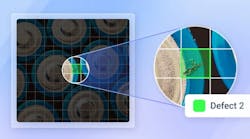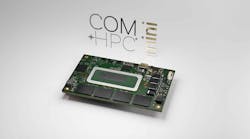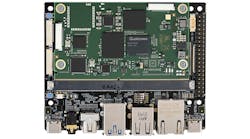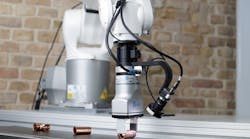The Automated Imaging Association (AIA)—the North American trade group for machine-vision technology—held its eighth Annual Business Conference in Orlando, FL, last February. Attendees numbered nearly 200, and many expressed favorable comments on the conference sessions, speakers, and events. As usual, this conference continued to provide networking opportunities for industry executives, technologists, and professionals and offered them new business insights, contacts, and relationships on both national and international levels.
Prior to the conference, David L. Dechow, president of Insight Integration Inc./ISRA Vision Systems North America, was re-elected by the AIA board to a second term as 2000-2001 AIA president. He stated, "As the machine-vision industry grows, the role of the AIA will change and grow. As an organization, we must consider the global machine-vision community and respond to the needs of the member companies as they compete in a global market."
The AIA also elected three new members for two-year terms on its board of directors: Steve Gordon, founder and president of Intelligent Automation Systems; Robert Steinke, chief executive officer and chairman of DVT Corp.; and Vic Wintriss, president of Wintriss Engineering Corp.
During the conference, the 2000 Automated Imaging Achievement Award was presented to Nello Zuech, president of Vision Systems International Inc. The award honors industry leaders for outstanding contributions in promoting market acceptance of industrial or scientific imaging. For the past 17 years, Zuech has operated as an independent engineering and marketing consultant in the fields of electronic imaging, machine vision, electro-optics, intelligent sensors, and nondestructive evaluation. In accepting the award, he commented, "When I think back on the early days, it amazes me how far we have come. Despite it not being very vigorous, that early technology was used on demonstration projects that have since developed into key imaging markets-optical character recognition, digital radiography, disease-specific diagnostics, TV interferometry, optical computing, and machine vision."
In the opening session, Tom Madsen, president and chief executive officer of Key Technology Inc., presented "How to build a successful machine-vision company." He pointed out his company's critical success factors over the past 50 years in installing more than 900 inspection systems and 8000 conveying systems, mainly for the food-processing industry. These factors, said Madsen, included a focus on applications, the use of applied technology in an integrated systems approach, and, most important, a complete customer focus from concept to startup to service. He also commented that the future of machine vision would rely on user-friendly systems, mainly for low-skilled workers.
Amir Novini, president of Applied Vision Corp., presented "The story of a start-up." He itemized all the personnel, money, and legal obstacles encountered in planning and operating his three-year-old company. Some key problems were finding an imaging system that worked as advertised and required and discovering that the majority of machine-vision devices are difficult to use. According to Novini, company success is related to the right mix of individuals and their capabilities, an unrelenting pursuit of goals, and hard work.
The highlight of the conference is the annual AIA machine-vision market survey and forecast report. As he has done for the past seven years, Nello Zuech compiled and presented the 1999 machine-vision market study. He stated that the total North American machine-vision merchant and value-added markets totaled $1.714 billion in 1999, an increase of 8.5% over the total of
$1.58 billion in 1998. Compared to the 1998 results, the leading end-user industries were semiconductor, at $484.8 million, a rise of 15%; electronics, at $195 million, a drop of 6%; miscellaneous, at $115 million, a drop of 38%; food processing, at $93 million, a drop of 6%; and transportation, at $84 million, a fall of 3%. For the merchant machine-vision industry, Zuech reported that revenues increased 13%, units shipped increased 22.9%, and average unit price decreased 7.6%. He also commented that the smart camera market made major strides in 1999 with revenues up 63.9%, units shipped rising 139%, and average unit price declining 31.5%.
Looking at vision from a researcher's perspective, Ron Seilinski, an engineer at Microsoft's Vision Technology Group, reported on the company's experimental work on a vision software development kit, image-modeling and rendering, and intelligent video analysis. He explained a seven-year research program started less than a year ago—The EasyLiving Project—which seeks to build a home or office environment where human interaction occurs in a natural manner. It involves the coordination of cameras, robust tracking of human movements, and combining multiple sensory modalities. For industrial applications, Seilinski said that automation systems are being redesigned to take advantage of distributed architecture and Internet technology, users will be able to choose applications that suit their businesses, and planning systems will be integrated with control systems to take advantage of plant floor data.
On behalf of the 1394 Trade Association (www.1394ta.org), Mike Oitzman, senior product manager at Adept Technology Inc., spoke on "FireWire, a vision for the future." Structured as a digital bus for interfacing industrial cameras and other factory floor devices with image-processing units, FireWire, or IEEE-1394, said Oitzman, offers simple plug and play, system-architecture flexibility, and future scalability. The next generation of the FireWire protocol, 1394B, will provide extended fiber and copper-cable distances to 100 m and maximum data rates to 1.6 Gbit/s.
Professor Bernd Jahne of the Interdisciplinary Center for Scientific Computing at the University of Heidelberg in Germany discussed a range of academic imaging research projects. A major effort is being focused on thin film on ASIC solid-state, black-and-white and color imaging-sensor technology, which involves deposing a photosensitive layer on a silicon chip. The benefits achieved include fill factors to 100%, independent optimization of detector and associated circuits, superior photoelectric properties, applied voltage shifting of spectral response, dynamic range to 150 dB, and low CMOS cost.
Presenting Wall Street's view of the machine-vision industry was Will Potter, a founding member of ING Barings Industrial Manufacturing Group. According to Potter, cycle-time reduction, or the time-based competition of getting a product to the customer's door, has emerged as the key (underexploited) growth demand driver for industrial manufacturing technologies. He added that for supply-chain technologies, delivery time is the growth driver, and for customer-service technologies, wasted time elimination is key.
—George Kotelly
[email protected]






